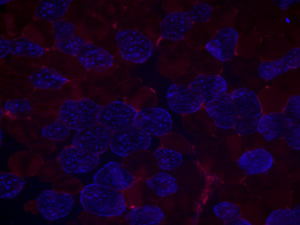By Alec Chaves
Hard work and discipline are important factors in determining success, no matter what the goal. This also holds true in sports this also holds true, although there are a host of other factors that can help increase one’s chances of becoming a successful athlete. As a scientist and a sports fan, I find it fascinating when these two areas come together to determine the biological factors that contribute to athletic success. One of these factors is the ACTN3 gene.

Like other genes in the human genome, ACTN3 holds the blueprint for a protein’s design, which, in this case, is alpha actinin-3. Alpha actinin-3 is a structural protein found in the z-disc of the muscle cell, a structure I have discussed in a previous post. What is fascinating, however, is that the presence of alpha actinin-3 increases the speed and power with which a muscle cell can produce force. Before getting into that, I first need to tell you that our skeletal muscle cells come in two forms, type I (slow) and type II (fast). On the right, I have included an image from my lab of a piece of muscle tissue that was stained with fluorescent chemicals to identify type I fibers (blue) and type II fibers (red). Type I cells produce very little power, but they can stay active for very long periods of time without tiring, or fatiguing. Type II cells, on the other hand, can produce much more power, but fatigue very quickly. Therefore, type I cells are useful for long distance running or cycling, whereas type II cells are useful for sprinting or throwing. Usain Bolt for example, has a very high percentage of type II muscle fibers in his legs, helping him sprint across the finish line in record times. Alpha actinin-3 increases the percentage of type II muscle cells in a person’s muscle tissue. Therefore, you could predict that someone with more alpha actinin-3 would have a higher percentage of type II muscle cells, which would help them perform quick and high energy activities like sprinting.

This prediction turns out to be supported by several studies, which have found associations between sprinting performance and levels of alpha actinin-3 in elite sprinters. Strengthening this idea, a recent case study published by Ball State University revealed that a former elite sprinter with elevated levels of alpha actinin-3 had 5 TIMES the normal amount of fast type II muscle cells in their thigh muscle.
It is important to note that ~20% of people have a mutation in ACTN3 and cannot produce any alpha actinin-3 at all. These individuals are perfectly healthy and would have no idea they have this mutation unless they underwent genetic testing. Instead, they have an exceptionally high percentage of type I muscle fibers and, as expected, a high percentage of elite endurance runners have the mutated variant of this gene.
Although interesting, ACTN3 is one gene out of the thousands that can affect athletic performance. The studies that I have referenced above merely uncover associations between ACTN3 and sports performance and in no way dictate whether a person can become a successful sprint athlete or endurance athlete.
If the topic of sports genetics interests you, I would highly recommend the book “The Sports Gene: Inside the Science of Extraordinary Athletic Performance” By David Epstein.
Edited by Emma Goldberg and Anna Wheless
